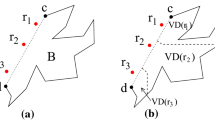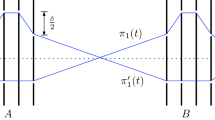Abstract
We reduce the problem of computing an \(L_1\) shortest path between two given points s and t in the given splinegonal domain \(\mathcal {S}\) to the problem of computing an \(L_1\) shortest path between two points in the polygonal domain. Our reduction algorithm defines a polygonal domain \(\mathcal {P}\) from \(\mathcal {S}\) by identifying a coreset of points on the boundaries of splinegons in \(\mathcal {S}\). Further, it transforms a shortest path between s and t among polygonal obstacles in \(\mathcal {P}\) to a shortest path between s and t among splinegonal obstacles in \(\mathcal {S}\). When \(\mathcal {S}\) is comprised of h pairwise disjoint simple splinegons defined with a total of n vertices, excluding the time to compute an \(L_1\) shortest path among simple polygonal obstacles in \(\mathcal {P}\), our reduction algorithm takes \(O(n + h \lg {n} + (\lg {h})^{1+\epsilon })\) time. Here, \(\epsilon \) is a small positive constant [resulting from the triangulation of the free space using Bar-Yehuda and Chazelle (Int J Comput Geom Appl 4(4):475–481, 1994)]. For the special case of \(\mathcal {S}\) comprising of concave-out splinegons, we have devised another reduction algorithm. This algorithm does not rely on the structures used in the algorithm (Inkulu and Kapoor in Comput Geom 42(9):873–884, 2009) to compute an \(L_1\) shortest path in the polygonal domain. Further, we have characterized few of the properties of \(L_1\) shortest paths among splinegons which could be of independent interest.











Similar content being viewed by others
References
Agarwal PK, Sharathkumar R, Yu H (2009) Approximate Euclidean shortest paths amid convex obstacles. In: Proceedings of symposium on discrete algorithms, pp 283–292
Arikati SR, Chen DZ, Chew LP, Das G, Smid MHM, Zaroliagis CD (1996) Planar spanners and approximate shortest path queries among obstacles in the plane. In: Proceedings of European symposium on algorithms, pp 514–528
Atallah M, Chen DZ (1993) On parallel rectilinear obstacle-avoiding paths. Comput Geom 3(6):307–313
Bar-Yehuda R, Chazelle B (1994) Triangulating disjoint Jordan chains. Int J Comput Geom Appl 4(4):475–481
Chen DZ, Klenk KS (1996) Rectilinear short path queries among rectangular obstacles. Inf Process Lett 57(6):313–319
Chen DZ, Wang H (2011) A nearly optimal algorithm for finding $L_1$ shortest paths among polygoal obstacles in the plane. In: Proceedings of European symposium on algorithms, pp 481–492
Chen DZ, Wang H (2015) Computing shortest paths among curved obstacles in the plane. ACM Trans Algorithms 11(4):26:1–26:46
Chen DZ, Inkulu R, Wang H (2016) Two-point $L_1$ shortest path queries in the plane. J Comput Geom 7(1):473–519
Clarkson KL, Kapoor S, Vaidya PM (1987) Rectilinear shortest paths through polygonal obstacles in $O(n(\lg {n})^2)$ time. In: Proceedings of symposium on computational geometry, pp 251–257
de Berg M, Cheong O, van Kreveld M, Overmars M (2008) Computational geometry: algorithms and applications, 3rd edn. Springer, Berlin
de Rezende PJ, Lee DT, Wu Y-F (1989) Rectilinear shortest paths in the presence of rectangular barriers. Discrete Comput Geom 4:41–53
Dobkin DP, Souvaine DL (1990) Computational geometry in a curved world. Algorithmica 5(3):421–457
Dobkin DP, Souvaine DL, Van Wyk CJ (1988) Decomposition and intersection of simple splinegons. Algorithmica 3:473–485
ElGindy HA, Mitra P (1994) Orthogonal shortest route queries among axis parallel rectangular obstacles. Int J Comput Geom Appl 4(1):3–24
Ghosh SK (2007) Visibility algorithms in the plane. Cambridge University Press, New York
Ghosh SK, Mount DM (1991) An output-sensitive algorithm for computing visibility graphs. SIAM J Comput 20(5):888–910
Guibas LJ, Hershberger J (1989) Optimal shortest path queries in a simple polygon. J Comput Syst Sci 39(2):126–152
Hershberger J (1991) A new data structure for shortest path queries in a simple polygon. Inf Process Lett 38(5):231–235
Hershberger J, Snoeyink J (1994) Computing minimum length paths of a given homotopy class. Comput Geom 4(2):63–97
Hershberger J, Suri S (1999) An optimal algorithm for Euclidean shortest paths in the plane. SIAM J Comput 28(6):2215–2256
Hershberger J, Suri S, Yildiz H (2012) A near-optimal algorithm for shortest paths among curved obstacles in the plane. In: Proceedings of symposuim on computational geometry, pp 359–368
Inkulu R, Kapoor S (2009) Planar rectilinear shortest path computation using corridors. Comput Geom 42(9):873–884
Inkulu R, Kapoor S (2019) Approximate Euclidean shortest paths amid polygonal obstacles. In: Proceedings of symposium on algorithms and computation
Inkulu R, Kapoor S, Maheshwari SN (2010) A near optimal algorithm for finding Euclidean shortest path in polygonal domain. CoRR, arXiv:1011.6481
Kapoor S, Maheshwari SN (2000) Efficiently constructing the visibility graph of a simple polygon with obstacles. SIAM J Comput 30(3):847–871
Kapoor S, Maheshwari SN, Mitchell JSB (1997) An efficient algorithm for Euclidean shortest paths among polygonal obstacles in the plane. Discrete Comput Geom 18(4):377–383
Kapoor S, Maheshwari SN (1998) Efficent algorithms for Euclidean shortest path and visibility problems with polygonal obstacles. In: Proceedings of symposium on computational geometry, pp 172–182
Melissaratos EA, Souvaine DL (1992) Shortest paths help solve geometric optimization problems in planar regions. SIAM J Comput 21(4):601–638
Mitchell JSB (1989) An optimal algorithm for shortest rectilinear paths among obstacles. In: Canadian conference on computational geometry, p 22
Mitchell JSB (1992) $L_1$ shortest paths among polygonal obstacles in the plane. Algorithmica 8(1):55–88
Mitchell JSB (1996) Shortest paths among obstacles in the plane. Int J Comput Geom Appl 6(3):309–332
Mitra BK, Bhattacharya P (1993) Efficient approximate shortest-path queries among isothetic rectangular obstacles. In: Proceedings of the third workshop on algorithms and data structures, pp 518–529
Rohnert H (1986) Shortest paths in the plane with convex polygonal obstacles. Inf Process Lett 23(2):71–76
Storer JA, Reif JH (1994) Shortest paths in the plane with polygonal obstacles. J ACM 41(5):982–1012
Acknowledgements
R. Inkulu’s research was supported in part by NBHM Grant 248(17)2014-R&D-II/1049, and SERB MATRICS Grant MTR/2017/000474.
Author information
Authors and Affiliations
Corresponding author
Additional information
Publisher's Note
Springer Nature remains neutral with regard to jurisdictional claims in published maps and institutional affiliations.
Rights and permissions
About this article
Cite this article
Choudhury, T., Inkulu, R. Computing an \(L_1\) shortest path among splinegonal obstacles in the plane. J Comb Optim 44, 1594–1614 (2022). https://doi.org/10.1007/s10878-020-00524-0
Published:
Issue Date:
DOI: https://doi.org/10.1007/s10878-020-00524-0




